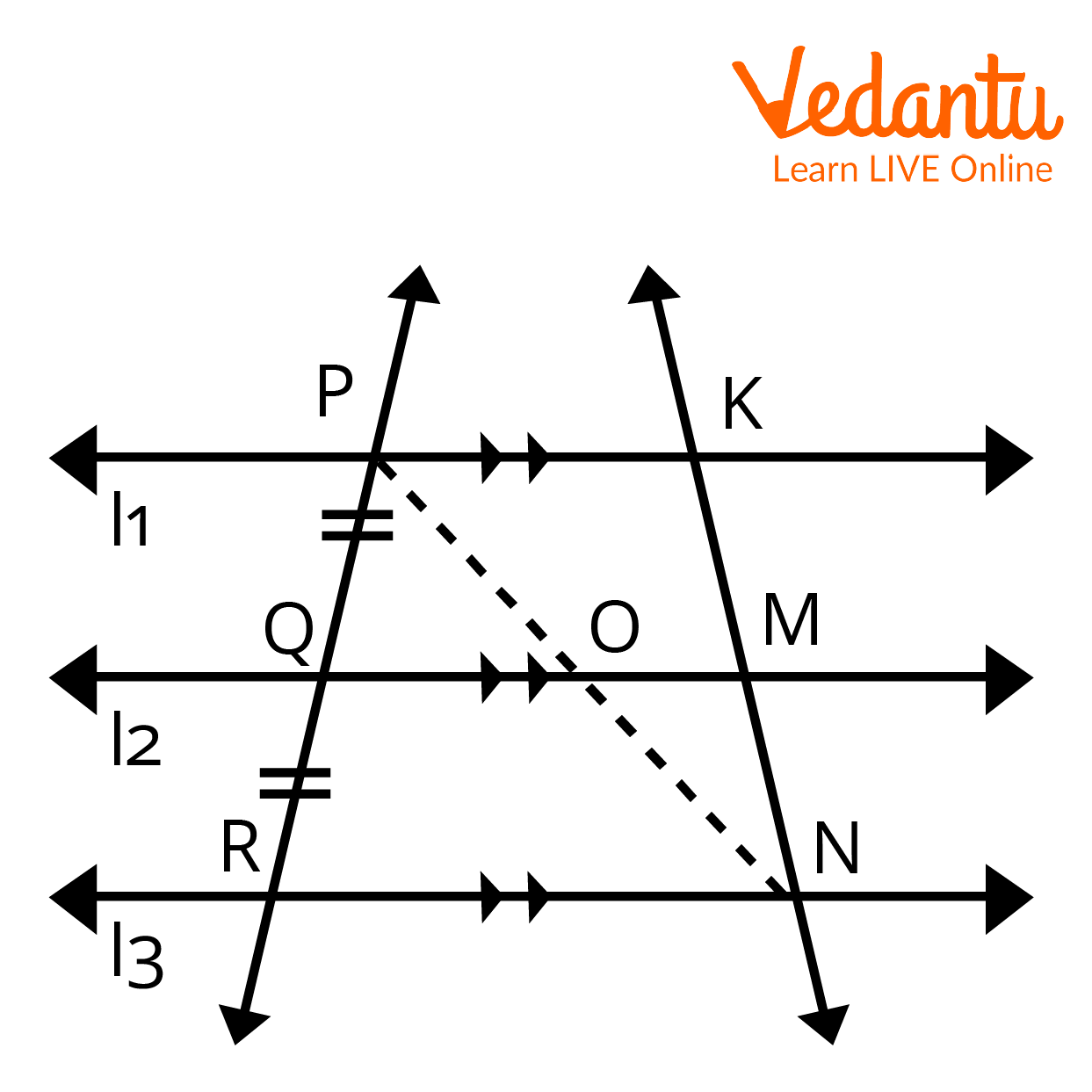




An Overview of the Theorem
The Intercept Theorem is a fundamental tool of Euclidean Geometry. The concept of parallel lines and transversal is of great importance in our day-to-day life. And, the Intercept theorem extends our understanding of parallel lines and transversal and we can apply these concepts in our day-to-day life.

A Transversal
In the above figure, we can see that there are 3 parallel lines
History of the Mathematician

Euclid
Year of Birth: 325 BC
Year of Death: 270 BC
Contribution: He contributed significantly in the field of Mathematics and Physics by discovering the intercept theorem.
Statement of the Theorem
If there are three or more parallel lines and the intercepts made by them on one transversal are equal, the corresponding intercepts of any transversal are also equal.
Proof of the Theorem

Two Parallel Lines
Given:
The transversal
To prove:
Proof:
Draw a line
From the information above, we can say that
According to the properties of a parallelogram:
Similarly, we can say that
From the given information, we know that
So, from equations (1) and (2), we can say that
In
Hence,
As
Hence proved.
Applications of the Theorem
The intercept theorem can be used to prove that a certain construction yields parallel line segments:
If the midpoints of two triangle sides are connected, then the resulting line segment is parallel to the third triangle side (Mid point theorem of triangles).
If the midpoints of the two non-parallel sides of a trapezoid are connected, then the resulting line segment is parallel to the other two sides of the trapezoid.
Limitations of the Theorem
The intercept theorem is not able to help us in finding the midpoint of the sides of the triangle.
The basic proportionality theorem is an advanced version of the intercept theorem and it gives us a lot of information on the sides of the triangles.
Solved Examples
1. In a
Ans:

Scalene Triangle
So,
Interchanging the ratios,
Adding 1 to both sides,
Interchanging the ratios again,
Hence proved.
2. Find DE

Basic Proportionality Theorem
Ans: According to the basic proportionality theorem,
So,
3. In

Intercept Theorem
Ans:
Let
So,
So,
Important Points
The intercept theorem can only be applied when the lies are parallel, if the transversal is cutting lines that are not parallel, then the intercept theorem is not valid.
The basic proportionality theorem and mid-point theorem are all applications of the intercept theorem but they are not the same theorems.
Conclusion
In the above article, we have discussed the Equal intercept Theorem and its proof. We have also discussed the applications of the theorem. So, we can conclude that Intercept Theorem is a fundamental tool of Geometry and is based on applications of parallel lines and transversal and reduces our computational work based on its application as we have seen in the examples based on the theorem.






FAQs on Intercept Theorem
1. Are the basic proportionality theorem, mid-point theorem, and intercept theorem the same?
No, basic proportionality theorem, intercept theorem, and mid-point theorem are 3 different kinds of theorems. The intercept theorem is a very broad theorem and it tells about how the properties of a transversal change when they interact with parallel lines. The basic proportionality theorem is covering about the interaction of lines parallel to one side of the triangle with the other two sides and the basic proportionality theorem is derived from the intercept theorem. The midpoint theorem talks about when a line bisects the other two sides of a triangle, then it is parallel to the third side, and the midpoint theorem is derived from the basic proportionality theorem.
2. What is the mid-point theorem?
The line segment of a triangle connecting the midpoint of two sides of the triangle is said to be parallel to its third side and is also half the length of the third side, according to the midpoint theorem. The mid-point theorem is derived from the basic proportionality theorem and it is a very useful theorem in solving the questions of geometry as it directly gives the value of the sides of a triangle and also the parallel line helps to get the values of angles.
3. Why can’t the intercept theorem be used for non-parallel lines?
The intercept theorem cannot be used for non-parallel lines because there are a lot of things in the derivation of the intercept theorem which we won’t get if the lines are not parallel. Like we won’t be able to use the angles such as the alternate interior angles and the vertically opposite angles and much more. The construction that we make in the derivation is only made because the lines are parallel, hence if the lines are not parallel the intercept theorem is not valid.


























